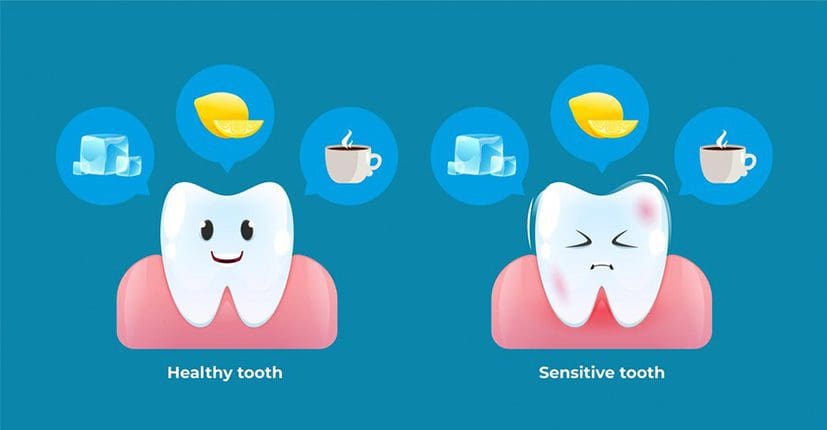Dentin hypersensitivity (DH) affects 57% of the general population and can have a negative impact on the quality of life and emotional well-being. DH peaks between the ages of 20-40 with a slightly higher prevalence in women. DH is marked by a sudden, sharp burst of pain when affected teeth are exposed to external stimuli including thermal shock (hot and cold), brushing or flossing, whitening, and consumption of acidic or sugary foods. Below we will discuss the cause of hypersensitivity and highlight effective at-home and in-office therapies.
In healthy teeth, a layer of enamel protects the crowns of your teeth (the part above the gum line). Underneath the enamel is dentin, which is less dense than enamel and contains microscopic tubules Dentin hypersensitivity occurs when external stimuli cause dentin tubular fluid movement, which triggers nerve fibers in the pulp and causes pain. This phenomenon is known as the hydrodynamic theory. Dentin tubule exposure can be caused by periodontal disease, gingival recession, cracked teeth, abrasion (aggressive burshing), erosion (chemical breakdown of the enamel), abfraction (loss of tooth structure) due to bruxism, excessive dietary acids (citrus fruits, soda, wine), gastric reflux, and tooth fractures.
Management of dental sensitivity will be determined based on etiology (causation) and severity. Schedule a dental appointment to identify the cause for dental hypersensitivity. Our approach starts with the most cost effective treatment as a first line of defense. In some cases, simple methods such as modification of diet and brushing techniques can reduce DH. Rinse your mouth right after eating or drinking acidic or sugary foods and brush within 30-45min. Avoid aggressive tooth brushing and choose an ADA recommended soft-bristled toothbrush. Replace your manual toothbrush every 4-6 weeks and electric toothbrush heads once every three months because the jagged edges may damage the enamel.
In addition to eliminating contributing factors, your dental health providers may recommend an at-home desensitizing toothpaste. The most common active ingredient in sensitivity toothpaste is 5% potassium nitrate (Sensodyne). The potassium ions penetrate the tubules and decrease nerve excitability over time. In addition to potassium nitrate, various fluoride formulations including sodium fluoride, stannous fluoride, sodium moofluorophospate and fluorosilicates have been incorporated into toothpastes to provide DH relief through sealing dentinal tubules or forming coagulates inside the tubules.
Clinical management of dental sensitivity aims to reduce dentinal tubule exposure through decreasing the porousness of dentin. Fluoride varnish is one of the most commonly used and highly effective in-office treatments for dental sensitivity. Fluoride varnish is a concentrated form of sodium fluoride suspended in an alcohol and resin-based solution. The varnish is applied directly to the tooth surface. The resin base allows the varnish to stick to the teeth, releasing high concentration of fluoride over a sustained period of time with less chance of systemic ingestion. Once absorbed, fluoride ions act to inhibit demineralization and enhance remineralization of the tooth surface. Fluoride varnishes also offer additional benefits such as caries formation in high risk populations.
Hypersensitive teeth caused by gum recession and erosion may require the placement of an adhesive composite resin or glass ionomer restoration to cover the exposed surface. A night guard can often provide DH relief when severe recession, abfraction or erosion occurs.

